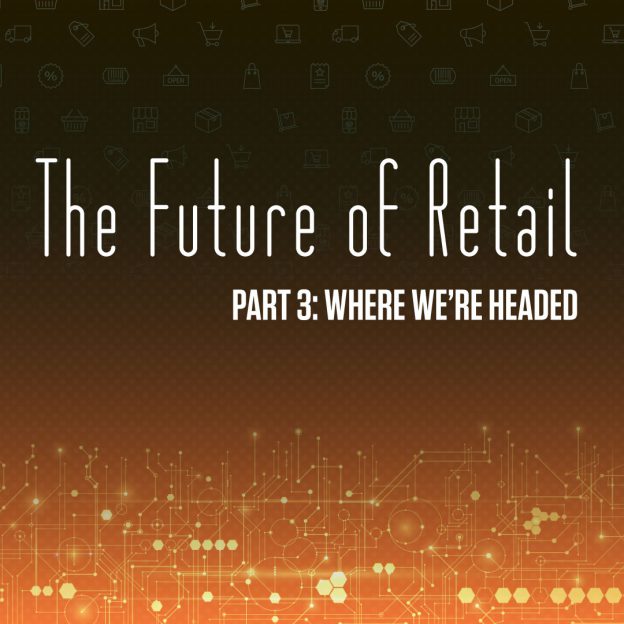The Future of Retail, Part 3: Where We’re Headed
05.10.2017
We’ve come to the final portion in our series on the future of retail. If you haven’t read Part 1 and Part 2, go do that now! We discussed how the retail industry has changed over the past couple of decades, as well as how technology has made an enormous impact on retail.
Join us by reading Part 3 below, where our very own BDS experts look deep into the retail crystal ball and make some bold predictions about the future of the industry!
Technology & Brick-and-Mortar Merge
Our first prediction revolves around the fact that technology could actually help brick-and-mortar retailers in the coming years. While Amazon and online shopping aren’t going away, physical store locations may be starting to gain back some of their competitive advantage through technology:
“Soon there will be an increase in in-store technology, with more interactive displays that will engage guests. The less time spent at the point of purchase (shorter lines) because of the ability to shop online will also attract consumers,” predicted our Senior Results Specialist, Julie M.
Our Account Planner, Jenny M., agreed: “Endcaps are starting to become more technologically advanced as brick-and-mortar retailers look to find new ways to attract online shoppers through advanced displays, events, and in-store activities,” she said.
In a blog that we published at the beginning of 2017, we predicted that remarkable in-store experiences will be necessary for retailers to bring people to their locations. Consumers, particularly Generation Z shoppers, are increasingly searching for virtual reality, augmented reality, and other types of unique in-store experiences fueled by technology. Even older shoppers will utilize these in-store experiences if the technology is easy enough for them to use and the benefits are clear. As one of our Recruiters, Brian M., predicts, look for this trend to continue: “Stores will be even more interactive by using technology. This allows customers to be able to see what products are available and how they could potentially look within their space at home or the office.”
Smaller Is Better
We may have already experienced the peak of massive department stores in the retail space. Target has announced that they will launch hundreds of smaller “flex-format” stores across the country. Many retailers are re-thinking store size as well, with consumers increasingly preferring smaller, more specialized boutiques.
“Specialty retailers like Best Buy are going to double down on the boutique experience, meaning less actual product in the store, while other retailers like Fry’s will continue to be the traditional brick-and-mortar they have been,” predicted our Senior Developer, John M.
Another expert also believes that the retail space will continue to splinter out into niche markets over the next 5-10 years:
“There will be fewer big players, and more experiential presence by brands, either in-store or via standalone brand shops,” said our SVP of Client Development, David T.
Space Dedicated to Manufacturers
If retailers do choose to keep large, warehouse-type spaces, expect them to be more dedicated to manufacturers, customer experience, and customer service. Tech brands like Samsung, Sony, and Apple have had success with this model. Mary M., our Director of Operations had a lot to say about this trend:
“In the near term, interactive displays with lower price-point items will continue to thrive. When considering the purchase of higher-priced items, like a TV or car, consumers will always use the Internet to price check, research, etc. When they come into the warehouse space to pick up an item, there is a terrific opportunity for residual sales to happen at other price points,” she said.
Online Shopping Continues
Even though brick-and-mortar retailers could use technology and transform their physical space to become more viable to the next generations of shoppers, make no mistake that the future of retail is still on the Internet.
Retailers must continue to focus on their online space, not only optimizing their eCommerce experience, but reaching new consumers through omni-channel social strategies. Many brands are even starting to develop a “social consciousness,” and at the very least, they must respect their perceived image on social media.
Anthony H., our Market Development Manager, points out that, “more and more people are becoming tech savvy and retailers are slowly shifting and downsizing overhead costs to continue making profits.”
Victor N., our Customer Service Specialist, sums it up nicely:
“The future is the Internet space. Places like Best Buy are morphing into advertising space for other companies. The retail space is more for advertising and demonstrating than it is sales. These days, and in the future, sales are happening in the comfort of your own home. Even groceries can be delivered to your front door.”
Do you agree with any of these predictions as to where the future of retail is heading? We’d love to hear from you! Contact us to share your thoughts or to connect with a BDS expert on how we can build your future at retail and beyond.